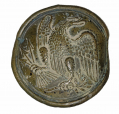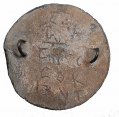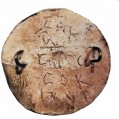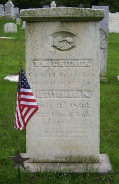site search
online catalog
CARVED CARTRIDGE BOX BELT PLATE OF WILLIAM CHURCH, CO. K 13th VERMONT, KILLED IN ACTION AT GETTYSBURG IN THE REPULSE OF PICKETT’S CHARGE, WITH BATTLE DAMAGE

$3,500.00 ON HOLD
Quantity Available: 1
Item Code: 2024-1804
CARVED CARTRIDGE BOX BELT PLATE OF WILLIAM CHURCH, CO. K 13th VERMONT, KILLED IN ACTION AT GETTYSBURG IN THE REPULSE OF PICKETT’S CHARGE, WITH BATTLE DAMAGE
“After the battle was won, and the victory was ours, and we were returning to a position in the front line, a hostile shell hit him and burst causing almost instant death. Among all the bodies that I had seen on this gory field, his was the most horribly mangled. On the following day we carefully gathered up his remains, moved them to the brow of a hill where we had dug a shallow grave and lovingly and tenderly placed him in it and at the head we set a mark that the place might be found should occasion require it.”
This remarkable round eagle cartridge box belt plate came out several decades ago through George Lower, well known among Civil War collectors and dealers as the longtime proprietor of the Gettysburg Sutler, and is clearly an early battlefield pick-up. It could not have come from a more historic spot or been worn by a soldier who gave more at critical moment in the battle. Corporal William Church, who owned it and carved his name, regiment and company on the back, was killed toward the end of the fighting on the July 3rd when it played a key role in the repulse Pickett’s Charge at Gettysburg, the regiment’s first and only major battle. Church is mentioned several times in the regimental history and a 2011 article in Vermont History by J. D. Book chronicles Church’s death and the return of his body to Vermont.
The plate is the regulation pattern, die-stamped rolled brass, embossed with the arms of the United States and attached to the cartridge box sling by an iron wire forming two loops, through which a thong would have passed, that is secured by the lead solder fill on the back of the plate. The plate shows a small impact point on what would be the wearer’s right and larger one on his struck on what would be his left, bending back the edge. Given that these were positioned on the left breast, the fragments striking the plate hit the wearer very close to the heart, though primary accounts by those near him indicate the Confederate shell burst practically upon him.
The face of the plate has a light, olive green patina, with some small dark spots, and light brown in the recesses around the edges of the eagle with arrows and olive branch. The lead fill is in place on the reverse, showing a mix of gray, white and light brown with just small losses around the circumference and wrinkling to the surface where the edge of the plate was forced back by the impact. The loops are in place, though one has been tilted slightly by the impact point next to it. The soldier carved his name on the reverse, “CPL / W / CHURCH / Co K / 13 VT.” The lettering is somewhat crude, likely done with a nail, pocket knife, or something else at hand, with the letters formed with straight lines, certainly the easiest way to carve something. The “W” is tad light at top. He had some trouble getting in all of his last name, having misjudged the space with the final “H” around the base of one the loop at right. It looks like it was in the ground for a period, but not all that long given the condition of the loops and lighter patina.
As most students of the battle will know, the regiment was a nine-month unit, due to muster out shortly when they were caught up in the battle. Organized in September 1862 at Brattleboro, VT, and mustered into service there in early October. Church, who had been born in Jericho, VT, was a 22-year old farmer living in Highgate when he enlisted Sept. 11 and was mustered into Company K as its 2nd Corporal October 10, having had three months prior military experience, May 2 to Aug. 15, 1861, as a private in Co. A 1st Vermont, which saw service around Fortress Monroe and saw action at Big Bethel. The 13th Vermont left the state the next day, October 11, reached Washington October 13 and then spent its time posted to Washington, Arlington, Munson’s Hill, Fairfax Courthouse, Wolf Run Shoals, and Warrenton Junction. Its sole brush with any enemy was taking part in the repulse of Jeb Stuart at Fairfax Courthouse on December 29.
This changed on June 25 when they, as part of Stannard’s Second Vermont Brigade, were assigned to the First Corps and started north, crossing the Potomac on June 27 and reaching the battlefield on the night of July 1. Posted near Cemetery Hill, they got their first taste of combat the next day when five of its companies were called upon to reinforce Hancock’s line along Cemetery Ridge, where several Confederate brigades had pushed across the Emmitsburg Road, driving back Union infantry and capturing some artillery. They arrived just in time to come up on the exposed left of Hall’s brigade and strike the right of Ambrose Wright’s Georgia brigade, which had come closest to the stone wall, helped repel the attack, and were credited with recapturing several guns and taking 83 prisoners when they managed to surround a farmhouse full of Confederate skirmishers and pickets later in the fighting.
On July 3 the reunited regiment was posted in roughly the same location, to the left of the Angle and Copse of Trees. Under fire from sharpshooters, and later artillery in the bombardment preparatory to Pickett’s advance, men of the regiment had created a low breastwork of fence rails in advance of the line on some better protected ground, as Pickett’s Charge began were posted with the 13th holding the right front of the brigade, the 16th VT on their left (and part of the 16th deployed as skirmishers even further to the left,) and the 14th VT in the second line. Their crucial action in the fight was Stannard’s decision to change front to right on the first company of 13th and advance 100 yards bringing them into position to deliver a devastating fire into the right of Kemper’s brigade despite the deployment by Kemper of his 11th and 24th Virginia, and the 8th Virginia by Garnett, to counter them. Not only that, as Pickett’s force began pulling back, Stannard then turned around part of the brigade, sending the 16th Vermont to hit the left of Lang’s and Wilcox’s Confederate brigades advancing belatedly to bolster Pickett.
Primary accounts in the regimental history make clear that Church survived this fighting and was killed by a shell burst just after they had secured the victory:
Soon after Companys I and G left the field in charge of prisoners, Colonel Randall received an order from General Stannard to move his regiment back to position, and as we were ascending the open field to reach our former position, a shell exploded in the ranks of Company K killing Corporal William Church and wounding privates James Monroe Hogaboom, and Clark H. Butterfield and others slightly. Quite a number were stunned and thrown to the ground by the concussion of the exploding shell. Lieutenant Stephen F. Brown stopped to see what could be done for Corporal Church who he found dying on the ground. His body scattered about and others killed and injured in that immediate vicinity among which were Sergeant Major Henry H. Smith, killed and Lieutenant Colonel Wm. D. Munson, injured, and while Lieutenant Brown was on his knees endeavoring to assist his fallen comrade another shell likely from the same gun exploded directly over his head and pretty close and the concussion prostrated and stunned him but Brown was soon able to reach his company and take his position, but not able to stand, and yet he remained on the field until the battle was over and the regiment relieved and ordered to the rear.
(We note that Lieutenant Brown is the same officer famous for entering the battle armed only with a camp hatchet, necessary in lieu of his sword, which had given up under temporary arrest for allowing his men to get water from a well during the hot march to Gettysburg- a camp hatchet may be seen on their regimental monument as a reminder.)
That was not the end of Church’s story, however: Book’s article goes on to quote the regimental historian: “Among the bodies that I had seen on this gory field, his was the most horribly mangled. On the following day we carefully gathered up his remains, moved them to the brow of a hill where we had dug a shallow grave and lovingly and tenderly placed him in it and at the head we set a mark that the place might be found should occasion require it.” He then goes on to note that Church’s family hired an agent to bring his body home in early November. The agent searched diligently, but was unable to locate the grave, unaware that he had been anticipated by William Church’s Captain, George G. Blake: “In a short time, Captain Blake, after he had mustered out, returned to that great battlefield where many thousands had been buried, and guided by the mark we left, readily found the grave, opened it, and found the body, and brought it to Vermont, and he was buried in the Church street cemetery at Swanton Falls, and a modest headstone now marks his last earthly resting place.”
In doing this, Captain Blake had fulfilled an agreement made among the men of the company that the bodies of any of them dying in the service would be sent home with the expense covered by the survivors.
We do not have the exact find location of the plate, but given the condition it was likely picked up not long after battle, perhaps at the location of Church’s death or where Ordnance teams had gathered arms and equipment salvaged on the field. It is also possible it was brought home by a veteran as a memento of a fallen comrade or even by Captain Blake. We include a photo of Church posted on a genealogy and a cemetery website. He is shown full standing in an infantry frock coat, with forage cap in hand. We see no rank insignia, making it likely it was taken during his earlier service with the 1st Vermont. [sr][ph:L]
~~~~~~~~~~~~~~~~~~~~~~~~~~~~~~~~~~~
THIS ITEM, AS WITH ALL OTHER ITEMS AVAILABLE ON OUR WEB SITE,
MAY BE PURCHASED THROUGH OUR LAYAWAY PROGRAM.
CLICK HERE FOR OUR POLICIES AND TERMS.
THANK YOU!
Inquire About CARVED CARTRIDGE BOX BELT PLATE OF WILLIAM CHURCH, CO. K 13th VERMONT, KILLED IN ACTION AT GETTYSBURG IN THE REPULSE OF PICKETT’S CHARGE, WITH BATTLE DAMAGE
For inquiries, please email us at [email protected]
Most Popular
Historical Firearms Stolen From The National Civil War Museum In Harrisburg, Pa »
Theft From Gravesite Of Gen. John Reynolds »
Selection Of Unframed Prints By Don Troiani »
Fine Condition Brass Infantry Bugle Insignia »
Wonderful Condition Original Confederate-Manufactured Kepi For A Drummer Boy Or Child »
featured item
WOODWARD GETTYSBURG LAMP USING A CONFEDERATE 12-POUND SIDE-LOADING SPHERICAL CASE SHOT
Local gunsmith Edward Woodward turned his talents to the relic business not long after the battle, selling relics picked up here to veterans and visitors as early as 1865, and is particularly known for his engraved artillery rounds and his desk sets.… (490-6965). Learn More »







